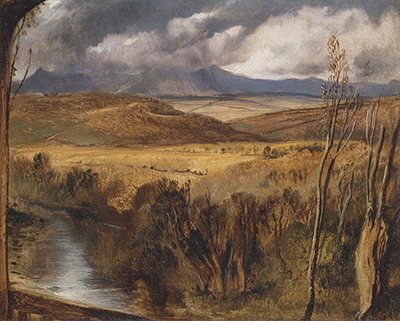A Highland Landscape is an oil on canvas painting completed in 1830 by Edwin Henry Landseer. It depicts a highland scene mountain covered by a thick cloud, a river and shrubs with a lovely warmth to the sky on a sunny day. This painting is professionally completed, with fine quality.
It is believed to have been inspired by Scotland’s shift in attitudes to the mountain landscapes. Just like in most of his other paintings, Henry focused more on colour than form.
Further Artworks
A Highland Breakfast, 1834, is among the many paintings sketched by Edwin Henry, inspired by the Scottish Highlands. In the painting is a young woman suckling her baby, surrounded by five dogs feeding from a tub. Here, Landseer brings out his prowess in combining genre with canine studies intimately.
The Monarch of the Glen 1851, is an oil on canvas painting, one of the most iconic and popular paintings in the 19th century. This painting portrays a snag wreathed in mist in the highland, emerging from the heather. It is one of the most reproduced paintings in all history, from the day it was completed. This painting has inspired artists such as Peter Saville, Henry Coombes and Peter Blake. The Monarch of the Glen has triggered numerous imitations in terms of engravings, prints and advertisements, meaning you could as well spot its outline in your whisky bottle or biscuit tin. This painting has been interpreted to be a symbol of a culture that gives rich men sports a priority over the poor.
Highland Music 1829 depicts a group of dogs listening and singing to music from their master. Landseer painted the image in Glen Fishier during his highland retreat, a place where the Duchess of Bedford had built wooden turf huts. It brings out a typical interior scene, which highlights the norm of the highlands. The image details clear light effects on the domestic utensils and a unique sense of humour on the dogs. The image portrays dogs howling at the sound of music produced by their master’s bagpipes.
Dying Stag, 1830, an oil on canvas painting portrays a stag’s rolling tongue and matted far on a stag lying helplessly on the ground, an indication that he is fatally wounded. The stag gives a poignant gaze in the surrounding. Landseer on his mission to explore the Scottish Highlands gave him a clearer picture of deer hunting and a better perspective of life and death.
Two Stags Running, 1820 depicts two animals viewed from a low eye level. One of them is created as a silhouette against the sky while the other is slightly cut off, as if almost outside the optical eye’s focus. Landseer uses a technique that heightens the emotive characterisation of animals as seen in the modern wildlife film. He lifts the grim facts to the level of high alert, an expression of defiance and competition.




